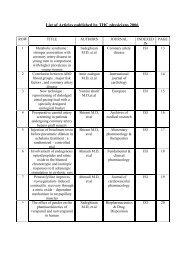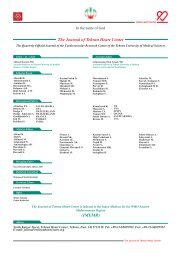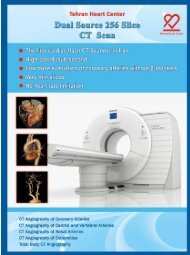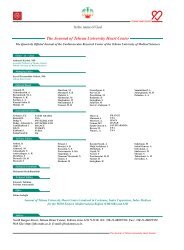THE JOURNAL OF TEHRAN UNIVERSITY HEART CENTER
THE JOURNAL OF TEHRAN UNIVERSITY HEART CENTER
THE JOURNAL OF TEHRAN UNIVERSITY HEART CENTER
Create successful ePaper yourself
Turn your PDF publications into a flip-book with our unique Google optimized e-Paper software.
The Journal of Tehran University Heart Center<br />
Ali Kazemisaeid et al.<br />
arterial dominance: in cases with right or balanced arterial<br />
coronary vascularization, the AVN artery was a branch of the<br />
RCA, and in cases of left dominance the left coronary artery<br />
gave a branch to the AVN. 15<br />
Dual supply of the AVN was a rare variation in the present<br />
sample of individuals. Such a dual supply has been described<br />
in the literature previously. 8, 10, 12-14, 16, 17 The co-dominant<br />
circulation seems not to be related to the dual arterial blood<br />
supply of the AVN insofar as in our study none of the 3<br />
patients with dual supply were co-dominant (one was leftdominant<br />
and the other 2 were right-dominant).<br />
Rusu MC et al., in an anatomic study of 50 human hearts,<br />
described five morphological types (each with distinctive<br />
subtypes) of the AVN artery: 1) type I (22%, the AVN artery<br />
from the U-turn of the RCA); 2) type II (18%, the AVN artery<br />
from the PDA); 3) type III (34%, the AVN artery from the<br />
PLB); 4) type IV (8%, the AVN artery from the bifurcation of<br />
the RCA into the PDA and the PLB-trifurcated RCA); and 5)<br />
type V (18%, the AVN artery from the circumflex artery). 18<br />
According to this type of classification, in our total study<br />
population the prevalence of each subtype was as follows:<br />
38.4% type I; 0.7% type II; 30.8% type III; 8.6% type IV;<br />
and 1.4% type V. We also observed additional subtypes such<br />
as origination from the OM, conus, proximal part of the RCA<br />
and ramus in 14.5%, 1.1%, 2.5%, and 0.3% of the subjects,<br />
respectively. Similar to the Russu study, the separation of the<br />
AVN artery from a non-crux origin was more common than<br />
that from the crux. Also in both studies, the most common<br />
non-crux origin of the AVN artery was from the PLB. The<br />
least common subtype in our study was origination from<br />
the PDA (and also ramus), in contrast to the Russu study, in<br />
which origination from the PDA was a common variation.<br />
By comparing the two study groups in our investigation, as<br />
is shown in Figure 2, this conclusion could be readily made<br />
that the origin of the AVN artery differed in the subjects with<br />
RBBB and those without RBBB.<br />
Conclusion<br />
According to our observations, there was no relationship<br />
between the dominancy of the epicardial arteries and the<br />
presence of RBBB in subjects with normal coronary arteries.<br />
There was a great variation of the AVN artery origin. Noncrux<br />
origination of the AVN artery was more common than<br />
the crux origination in both groups, and the prevalence of<br />
non-crux origination of the AVN artery was significantly<br />
higher in the cases than in the controls. Origination of the<br />
AVN artery from the right circulatory system was more<br />
common in both groups and the prevalence of the right origin<br />
of the AVN artery was significantly higher in the cases than<br />
in the controls. The AVN artery most commonly originated<br />
from the dominant artery but not necessarily from the crux.<br />
Acknowledgment<br />
This study was approved and supported by Tehran<br />
University of Medical Sciences.<br />
References<br />
1. Abuin G, Nieponice A. New findings on the origin of the<br />
blood supply to the atrioventricular node. Clinical and surgical<br />
significance. Tex Heart Inst J 1998;25:113-117.<br />
2. Knilans TK. Right bundle branch block. In: Surawicz B, ed. Chou’s<br />
Electrocardiography In Clinical Practice. 6th ed. Philadelphia:<br />
Saunders; 2008. p. 99-100.<br />
3. Mirvis DM, Goldberger AL. Electrocardiography. In: Bonow RO,<br />
Mann DL, Zipes DP, Libby P, Braunwald E, eds. Braunwald’s<br />
Heart Disease, A Textbook of Cardiovascular Medicine. 9th ed.<br />
Philadelphia: Saunders; 2011. p. 146-147.<br />
4. Stambler BS, Rahimtoola SH, Ellenbogen KA. Pacing for<br />
atrioventricular conduction system disease. In: Ellenbogen<br />
KA, Kay GN, eds. Clinical Cardiac Pacing, Defibrillation, and<br />
Resynchronization Therapy. 3rd ed. Philadelphia: Saunders; 2007.<br />
p. 429-430.<br />
5. Willems JL, Robles de Medina EO, Bernard R, Coumel P, Fisch<br />
C, Krikler D, Mazur NA, Meijler FL, Mogensen L, Moret P.<br />
Criteria for intraventricular conduction disturbances and preexcitation.<br />
World Health Organizational/International Society and<br />
Federation for Cardiology Task Force Ad Hoc. J Am Coll Cardiol<br />
1985;5:1261-1275.<br />
6. Pompa JJ. Coronary arteriography. In: Bonow RO, Mann DL,<br />
Table 4. Origin of the AVN artery reported by various authors<br />
Author Study date Sample size<br />
Origin of AVN artery (%)<br />
RCA LCX Dual<br />
Vieweg et al. 1975 118 84 8 8<br />
Hutchison 1978 40 80 20 -<br />
Hadziselimović 1978 200 85 13 2<br />
Krupa 1993 120 90 10 -<br />
Futami et al. 2003 30 80 10 10<br />
Saremietal 2008 102 87 11 2<br />
Ramanathan et al. 2009 300 72 28 0<br />
The present study 2011 276 72.1 26.4 1.1<br />
AVN, Atrioventricular node; RCA, Right coronary artery; LCX, Left circumflex artery<br />
168
















